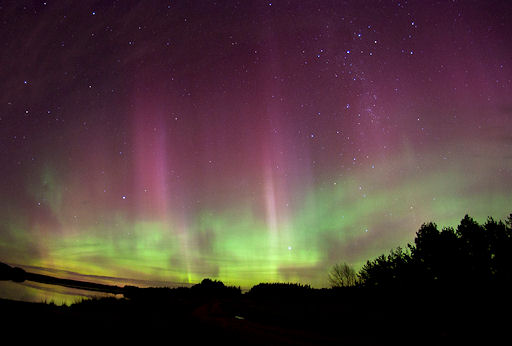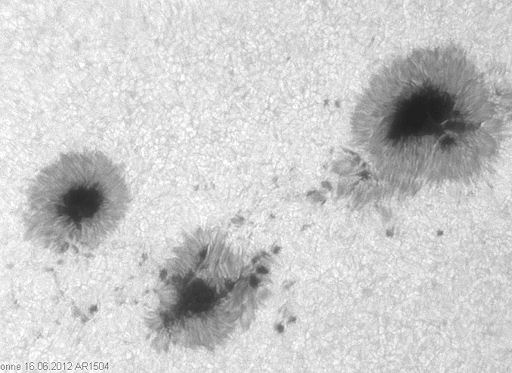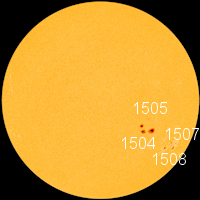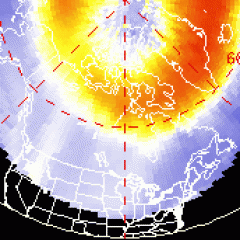~Space Weather Update~ GEOMAGNETIC STORM ALERT: [1]
GEOMAGNETIC STORM ALERT: A geomagnetic storm is in progress [2] in the wake of a double CME impact on June 16th. The hit, which strongly compressed Earth's magnetic field, lit up both poles with bright auroras. Stephen Voss sends this photo from Southland, New Zealand:
"We enjoyed a beautiful display of the Southern Lights from the south of New Zealand," says Voss. "A dull arc hung around for a couple of hours before suddenly exploding with a mixture of rays and curtains."
Meanwhile, in the Americas, Northern Lights descended as far south as Wisconsin [4], Minnesota [5], Iowa [6], Washington [7] and the [8] Dakotas [9].
Solar wind conditions in the wake of the CME favor continued disturbances. NOAA forecasters estimate a 55% chance of more high-latitude geomagnetic storms during the next 24 hours. Aurora alerts: text [10], voice [11].
Realtime Space Weather Photo Gallery [12]
CHANCE OF FLARES: Sunspot AR1504 has a complex 'beta-gamma' magnetic field that harbors energy for strong solar flares--and the huge sunspot is almost directly facing Earth. Amateur astronomer Eric von der Heyden photographed the behemoth on June 16th from his backyard observatory in Mühltal-Traisa, Germany:
Each of the dark cores in the image is about twice the size of Earth. The sheer size of the complex makes it an easy target for backyard solar telescopes [14].
NOAA forecasters estimate a 65% chance of M-flares and a 5% chance of X-flares from AR1504 during the next 24 hours. X-flare alerts: text [10], voice [11].
Readers, please scan the Realtime Photo Gallery [15] for constantly updated images of this sunspot plus a huge prominence [16] which has popped up on the sun's western limb.

![]()
Solar wind
speed: 432.9 km/sec
density: 15.2 protons/cm3
explanation [17] | more data [18]
Updated: Today at 1656 UT
![]()
X-ray Solar Flares
6-hr max: B7 1014 UT Jun17
24-hr: C1 0157 UT Jun17
explanation [19] | more data [20]
Updated: Today at: 1600 UT
![]()
![]()
![]()
Daily Sun: 17 Jun 12
![]()
![]()
Sunspot 1504 has a 'beta-gamma' magnetic field that poses a threat for strong M-class [22] solar flares. Credit: SDO/HMI
![]()
![]()
![]()
Sunspot number: 110
What is the sunspot number? [23]
Updated 16 Jun 2012
Spotless Days
Current Stretch: 0 days
2012 total: 0 days (0%)
2011 total: 2 days (<1%)
2010 total: 51 days (14%)
2009 total: 260 days (71%)
Since 2004: 821 days
Typical Solar Min: 486 days
Updated 16 Jun 2012
The Radio Sun
10.7 cm flux: 135 sfu
explanation [24] | more data [25]
Updated 16 Jun 2012
![]()
![]()
![]()
Current Auroral Oval:
![]()
Switch to: Europe, USA, New Zealand, Antarctica
Credit: NOAA/POES
![]()
![]()
![]()
Planetary K-index
Now: Kp= 5 storm
24-hr max: Kp= 6 storm
explanation [27] | more data [28]
![]()
Interplanetary Mag. Field
Btotal: 7.9 nT
Bz: 7.5 nT south
explanation [29] | more data [30]
Updated: Today at 1656 UT
![]()
![]()
![]()
Coronal Holes: 17 Jun 12
![]()
![]()
There are no large coronal holes on the Earthside of the sun. Credit: SDO/AIA.




